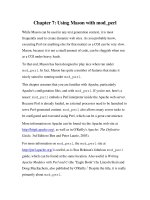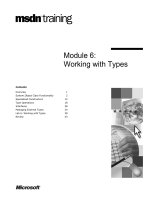Hacking Secret Ciphers with Python pptx
Bạn đang xem bản rút gọn của tài liệu. Xem và tải ngay bản đầy đủ của tài liệu tại đây (6.61 MB, 436 trang )
Hacking Secret
Ciphers with Python
By Al Sweigart
Copyright © 2013 by Al Sweigart
Some Rights Reserved. “Hacking Secret Ciphers with Python” is licensed under a Creative
Commons Attribution-Noncommercial-Share Alike 3.0 United States License.
You are free:
To Share — to copy, distribute, display, and perform the work
To Remix — to make derivative works
Under the following conditions:
Attribution — You must attribute the work in the manner specified by the author or
licensor (but not in any way that suggests that they endorse you or your use of the work).
(Visibly include the title and author's name in any excerpts of this work.)
Noncommercial — You may not use this work for commercial purposes.
Share Alike — If you alter, transform, or build upon this work, you may distribute
the resulting work only under the same or similar license to this one.
This summary is located here: Your fair use and other rights are
in no way affected by the above. There is a human-readable summary of the Legal Code (the full license), located here:
Book Version 1
Special thanks to Ari Lacenski. I can’t thank her enough. Without her efforts there’d be typos literally on every page.
Thanks to Jason Kibbe. Cover lock photo by “walknboston” Romeo
& Juliet and other public domain texts from Project Gutenberg. Various image resources from Wikipedia. Wrinkled
paper texture by Pink Sherbet Photography Computer User
icon by Katzenbaer.
If you've downloaded this book from a torrent, it’s probably out of date. Go
to to download the latest version.
ISBN 978-1482614374
1st Edition
Nedroid Picture Diary by Anthony Clark,
Movies and TV shows always make hacking look exciting with furious typing and meaningless
ones and zeros flying across the screen. They make hacking look like something that you have to
be super smart to learn. They make hacking look like magic.
It’s not magic. It’s based on computers, and everything computers do have logical
principles behind them which can be learned and understood. Even when you don’t
understand or when the computer does something frustrating or mysterious, there is always,
always, always a reason why.
And it’s not hard to learn. This book assumes you know nothing about cryptography or
programming, and helps you learn, step by step, how to write programs that can hack encrypted
messages. Good luck and have fun!
100% of the profits from this book are donated
to the Electronic Frontier Foundation, the Creative Commons, and the Tor Project.
Dedicated to Aaron Swartz, 1986 – 2013
“Aaron was part of an army of citizens that believes democracy
only works when the citizenry are informed, when we know about
our rights—and our obligations. An army that believes we must
make justice and knowledge available to all—not just the well born
or those that have grabbed the reins of power—so that we may
govern ourselves more wisely.
When I see our army, I see Aaron Swartz and my heart is broken.
We have truly lost one of our better angels.”
- C.M.
ABOUT THIS BOOK
There are many books that teach beginners how to write secret messages using ciphers. There are
a couple books that teach beginners how to hack ciphers. As far as I can tell, there are no books to
teach beginners how to write programs to hack ciphers. This book fills that gap.
This book is for complete beginners who do not know anything about encryption, hacking, or
cryptography. The ciphers in this book (except for the RSA cipher in the last chapter) are all
centuries old, and modern computers now have the computational power to hack their encrypted
messages. No modern organization or individuals use these ciphers anymore. As such, there’s no
reasonable context in which you could get into legal trouble for the information in this book.
This book is for complete beginners who have never programmed before. This book teaches basic
programming concepts with the Python programming language. Python is the best language for
beginners to learn programming: it is simple and readable yet also a powerful programming
language used by professional software developers. The Python software can be downloaded for
free from and runs on Linux, Windows, OS X, and the Raspberry Pi.
There are two definitions of “hacker”. A hacker is a person who studies a system (such as the
rules of a cipher or a piece of software) to understand it so well that they are not limited by the
original rules of that system and can creatively modify it to work in new ways. “Hacker” is also
used to mean criminals who break into computer systems, violate people’s privacy, and cause
damage. This book uses “hacker” in the first sense. Hackers are cool. Criminals are just people
who think they’re being clever by breaking stuff. Personally, my day job as a software
developer pays me way more for less work than writing a virus or doing an Internet scam would.
On a side note, don’t use any of the encryption programs in this book for your actual files.
They’re fun to play with but they don’t provide true security. And in general, you shouldn’t trust
the ciphers that you yourself make. As legendary cryptographer Bruce Schneier put it, “Anyone,
from the most clueless amateur to the best cryptographer, can create an algorithm that he himself
can’t break. It’s not even hard. What is hard is creating an algorithm that no one else can break,
even after years of analysis. And the only way to prove that is to subject the algorithm to years of
analysis by the best cryptographers around.”
This book is released under a Creative Commons license and is free to copy and distribute (as
long as you don’t charge money for it). The book can be downloaded for free from its website at
If you ever have questions about how these programs work,
feel free to email me at
TABLE OF CONTENTS
About This Book 6
Table of Contents 7
Chapter 1 - Making Paper Cryptography Tools 1
What is Cryptography? 2
Codes vs. Ciphers 3
Making a Paper Cipher Wheel 4
A Virtual Cipher Wheel 7
How to Encrypt with the Cipher Wheel 8
How to Decrypt with the Cipher Wheel 9
A Different Cipher Tool: The St. Cyr Slide 10
Practice Exercises, Chapter 1, Set A 11
Doing Cryptography without Paper Tools 11
Practice Exercises, Chapter 1, Set B 13
Double-Strength Encryption? 13
Programming a Computer to do Encryption 14
Chapter 2 - Installing Python 16
Downloading and Installing Python 17
Downloading pyperclip.py 18
Starting IDLE 18
The Featured Programs 19
Line Numbers and Spaces 20
Text Wrapping in This Book 20
Tracing the Program Online 21
Checking Your Typed Code with the Online Diff Tool 21
Copying and Pasting Text 21
More Info Links 22
Programming and Cryptography 22
Chapter 3 - The Interactive Shell 26
Some Simple Math Stuff 26
Integers and Floating Point Values 27
Expressions 27
Order of Operations 28
Evaluating Expressions 29
Errors are Okay! 29
Practice Exercises, Chapter 3, Set A 30
Every Value has a Data Type 30
Storing Values in Variables with Assignment Statements 30
Overwriting Variables 32
Using More Than One Variable 33
Variable Names 34
Practice Exercises, Chapter 3, Set B 35
Summary - But When Are We Going to Start Hacking? 35
Chapter 4 - Strings and Writing Programs 36
Strings 36
String Concatenation with the + Operator 38
String Replication with the * Operator 39
Printing Values with the print() Function 39
Escape Characters 40
Quotes and Double Quotes 41
Practice Exercises, Chapter 4, Set A 42
Indexing 42
Negative Indexes 43
Slicing 44
Blank Slice Indexes 45
Practice Exercises, Chapter 4, Set B 46
Writing Programs in IDLE’s File Editor 46
Hello World! 47
Source Code of Hello World 47
Saving Your Program 47
Running Your Program 48
Opening The Programs You’ve Saved 49
How the “Hello World” Program Works 50
Comments 50
Functions 50
The print() function 51
The input() function 51
Ending the Program 52
Practice Exercises, Chapter 4, Set C 52
Summary 52
Chapter 5 - The Reverse Cipher 53
The Reverse Cipher 53
Source Code of the Reverse Cipher Program 54
Sample Run of the Reverse Cipher Program 54
Checking Your Source Code with the Online Diff Tool 55
How the Program Works 55
The len() Function 56
Introducing the while Loop 57
The Boolean Data Type 58
Comparison Operators 58
Conditions 61
Blocks 61
The while Loop Statement 62
“Growing” a String 62
Tracing Through the Program, Step by Step 65
Using input() In Our Programs 67
Practice Exercises, Chapter 5, Section A 67
Summary 68
Chapter 6 - The Caesar Cipher 69
Implementing a Program 69
Source Code of the Caesar Cipher Program 70
Sample Run of the Caesar Cipher Program 71
Checking Your Source Code with the Online Diff Tool 72
Practice Exercises, Chapter 6, Set A 72
How the Program Works 72
Importing Modules with the import Statement 72
Constants 73
The upper() and lower() String Methods 74
The for Loop Statement 75
A while Loop Equivalent of a for Loop 76
Practice Exercises, Chapter 6, Set B 77
The if Statement 77
The else Statement 78
The elif Statement 78
The in and not in Operators 79
The find() String Method 80
Practice Exercises, Chapter 6, Set C 81
Back to the Code 81
Displaying and Copying the Encrypted/Decrypted String 83
Encrypt Non-Letter Characters 84
Summary 85
Chapter 7 - Hacking the Caesar Cipher with the Brute-Force Technique 87
Hacking Ciphers 87
The Brute-Force Attack 88
Source Code of the Caesar Cipher Hacker Program 88
Sample Run of the Caesar Cipher Hacker Program 89
How the Program Works 90
The range() Function 90
Back to the Code 92
String Formatting 93
Practice Exercises, Chapter 7, Set A 94
Summary 94
Chapter 8 - Encrypting with the Transposition Cipher 95
Encrypting with the Transposition Cipher 95
Practice Exercises, Chapter 8, Set A 97
A Transposition Cipher Encryption Program 97
Source Code of the Transposition Cipher Encryption Program 97
Sample Run of the Transposition Cipher Encryption Program 98
How the Program Works 99
Creating Your Own Functions with def Statements 99
The Program’s main() Function 100
Parameters 101
Variables in the Global and Local Scope 103
The global Statement 103
Practice Exercises, Chapter 8, Set B 105
The List Data Type 105
Using the list() Function to Convert Range Objects to Lists 107
Reassigning the Items in Lists 108
Reassigning Characters in Strings 108
Lists of Lists 108
Practice Exercises, Chapter 8, Set C 109
Using len() and the in Operator with Lists 109
List Concatenation and Replication with the + and * Operators 110
Practice Exercises, Chapter 8, Set D 111
The Transposition Encryption Algorithm 111
Augmented Assignment Operators 113
Back to the Code 114
The join() String Method 116
Return Values and return Statements 117
Practice Exercises, Chapter 8, Set E 117
Back to the Code 118
The Special __name__ Variable 118
Key Size and Message Length 119
Summary 119
Chapter 9 - Decrypting with the Transposition Cipher 121
Decrypting with the Transposition Cipher on Paper 122
Practice Exercises, Chapter 9, Set A 123
A Transposition Cipher Decryption Program 124
Source Code of the Transposition Cipher Decryption Program 124
How the Program Works 125
The math.ceil(), math.floor() and round() Functions 126
The and and or Boolean Operators 130
Practice Exercises, Chapter 9, Set B 131
Truth Tables 131
The and and or Operators are Shortcuts 132
Order of Operations for Boolean Operators 133
Back to the Code 133
Practice Exercises, Chapter 9, Set C 135
Summary 135
Chapter 10 - Programming a Program to Test Our Program 136
Source Code of the Transposition Cipher Tester Program 137
Sample Run of the Transposition Cipher Tester Program 138
How the Program Works 139
Pseudorandom Numbers and the random.seed() Function 139
The random.randint() Function 141
References 141
The copy.deepcopy() Functions 145
Practice Exercises, Chapter 10, Set A 146
The random.shuffle() Function 146
Randomly Scrambling a String 147
Back to the Code 147
The sys.exit() Function 148
Testing Our Test Program 149
Summary 150
Chapter 11 - Encrypting and Decrypting Files 151
Plain Text Files 152
Source Code of the Transposition File Cipher Program 152
Sample Run of the Transposition File Cipher Program 155
Reading From Files 155
Writing To Files 156
How the Program Works 157
The os.path.exists() Function 158
The startswith() and endswith() String Methods 159
The title() String Method 160
The time Module and time.time() Function 161
Back to the Code 162
Practice Exercises, Chapter 11, Set A 163
Summary 163
Chapter 12 - Detecting English Programmatically 164
How Can a Computer Understand English? 165
Practice Exercises, Chapter 12, Section A 167
The Detect English Module 167
Source Code for the Detect English Module 167
How the Program Works 168
Dictionaries and the Dictionary Data Type 169
Adding or Changing Items in a Dictionary 170
Practice Exercises, Chapter 12, Set B 171
Using the len() Function with Dictionaries 171
Using the in Operator with Dictionaries 171
Using for Loops with Dictionaries 172
Practice Exercises, Chapter 12, Set C 172
The Difference Between Dictionaries and Lists 172
Finding Items is Faster with Dictionaries Than Lists 172
The split() Method 173
The None Value 174
Back to the Code 175
“Divide by Zero” Errors 176
The float(), int(), and str() Functions and Integer Division 177
Practice Exercises, Chapter 12, Set D 178
Back to the Code 178
The append() List Method 179
Default Arguments 180
Calculating Percentage 181
Practice Exercises, Chapter 12, Set E 182
Summary 182
Chapter 13 - Hacking the Transposition Cipher 184
Source Code of the Transposition Cipher Hacker Program 184
Sample Run of the Transposition Breaker Program 186
How the Program Works 187
Multi-line Strings with Triple Quotes 187
Back to the Code 188
The strip() String Method 190
Practice Exercises, Chapter 13, Set A 192
Summary 192
Chapter 14 - Modular Arithmetic with the Multiplicative and Affine Ciphers 193
Oh No Math! 194
Math Oh Yeah! 194
Modular Arithmetic (aka Clock Arithmetic) 194
The % Mod Operator 196
Practice Exercises, Chapter 14, Set A 196
GCD: Greatest Common Divisor (aka Greatest Common Factor) 196
Visualize Factors and GCD with Cuisenaire Rods 197
Practice Exercises, Chapter 14, Set B 199
Multiple Assignment 199
Swapping Values with the Multiple Assignment Trick 200
Euclid’s Algorithm for Finding the GCD of Two Numbers 200
“Relatively Prime” 202
Practice Exercises, Chapter 14, Set C 202
The Multiplicative Cipher 202
Practice Exercises, Chapter 14, Set D 204
Multiplicative Cipher + Caesar Cipher = The Affine Cipher 204
The First Affine Key Problem 204
Decrypting with the Affine Cipher 205
Finding Modular Inverses 206
The // Integer Division Operator 207
Source Code of the cryptomath Module 207
Practice Exercises, Chapter 14, Set E 208
Summary 208
Chapter 15 - The Affine Cipher 210
Source Code of the Affine Cipher Program 211
Sample Run of the Affine Cipher Program 213
Practice Exercises, Chapter 15, Set A 213
How the Program Works 213
Splitting One Key into Two Keys 215
The Tuple Data Type 215
Input Validation on the Keys 216
The Affine Cipher Encryption Function 217
The Affine Cipher Decryption Function 218
Generating Random Keys 219
The Second Affine Key Problem: How Many Keys Can the Affine Cipher Have? 220
Summary 222
Chapter 16 - Hacking the Affine Cipher 223
Source Code of the Affine Cipher Hacker Program 223
Sample Run of the Affine Cipher Hacker Program 225
How the Program Works 225
The Affine Cipher Hacking Function 227
The ** Exponent Operator 227
The continue Statement 228
Practice Exercises, Chapter 16, Set A 231
Summary 231
Chapter 17 - The Simple Substitution Cipher 232
The Simple Substitution Cipher with Paper and Pencil 233
Practice Exercises, Chapter 17, Set A 233
Source Code of the Simple Substitution Cipher 234
Sample Run of the Simple Substitution Cipher Program 236
How the Program Works 236
The Program’s main() Function 237
The sort() List Method 238
Wrapper Functions 239
The Program’s translateMessage() Function 240
The isupper() and islower() String Methods 242
Practice Exercises, Chapter 17, Set B 244
Generating a Random Key 244
Encrypting Spaces and Punctuation 244
Practice Exercises, Chapter 17, Set C 246
Summary 246
Chapter 18 - Hacking the Simple Substitution Cipher 247
Computing Word Patterns 248
Getting a List of Candidates for a Cipherword 249
Practice Exercises, Chapter 18, Set A 250
Source Code of the Word Pattern Module 250
Sample Run of the Word Pattern Module 252
How the Program Works 253
The pprint.pprint() and pprint.pformat() Functions 253
Building Strings in Python with Lists 254
Calculating the Word Pattern 255
The Word Pattern Program’s main() Function 256
Hacking the Simple Substitution Cipher 258
Source Code of the Simple Substitution Hacking Program 259
Hacking the Simple Substitution Cipher (in Theory) 262
Explore the Hacking Functions with the Interactive Shell 263
How the Program Works 268
Import All the Things 268
A Brief Intro to Regular Expressions and the sub() Regex Method 269
The Hacking Program’s main() Function 270
Partially Hacking the Cipher 270
Blank Cipherletter Mappings 272
Adding Letters to a Cipherletter Mapping 272
Intersecting Two Letter Mappings 274
Removing Solved Letters from the Letter Mapping 275
Hacking the Simple Substitution Cipher 277
Creating a Key from a Letter Mapping 280
Couldn’t We Just Encrypt the Spaces Too? 282
Summary 282
Chapter 19 - The Vigenère Cipher 283
Le Chiffre Indéchiffrable 284
Multiple “Keys” in the Vigenère Key 284
Source Code of Vigenère Cipher Program 287
Sample Run of the Vigenère Cipher Program 290
How the Program Works 290
Summary 294
Chapter 20 - Frequency Analysis 295
The Code for Matching Letter Frequencies 300
How the Program Works 302
The Most Common Letters, “ETAOIN” 303
The Program’s getLettersCount() Function 303
The Program’s getItemAtIndexZero() Function 304
The Program’s getFrequencyOrder() Function 304
The sort() Method’s key and reverse Keyword Arguments 306
Passing Functions as Values 307
Converting Dictionaries to Lists with the keys(), values(), items() Dictionary Methods 309
Sorting the Items from a Dictionary 310
The Program’s englishFreqMatchScore() Function 311
Summary 312
Chapter 21 - Hacking the Vigenère Cipher 313
The Dictionary Attack 314
Source Code for a Vigenère Dictionary Attack Program 314
Sample Run of the Vigenère Dictionary Hacker Program 315
The readlines() File Object Method 316
The Babbage Attack & Kasiski Examination 316
Kasiski Examination, Step 1 – Find Repeat Sequences’ Spacings 316
Kasiski Examination, Step 2 – Get Factors of Spacings 317
Get Every Nth Letters from a String 318
Frequency Analysis 318
Brute-Force through the Possible Keys 320
Source Code for the Vigenère Hacking Program 321
Sample Run of the Vigenère Hacking Program 327
How the Program Works 329
Finding Repeated Sequences 330
Calculating Factors 332
Removing Duplicates with the set() Function 333
The Kasiski Examination Algorithm 336
The extend() List Method 336
The end Keyword Argument for print() 342
The itertools.product() Function 343
The break Statement 347
Practice Exercises, Chapter 21, Set A 348
Modifying the Constants of the Hacking Program 349
Summary 350
Chapter 22 - The One-Time Pad Cipher 351
The Unbreakable One-Time Pad Cipher 352
Why the One-Time Pad is Unbreakable 352
Beware Pseudorandomness 353
Beware the Two-Time Pad 353
The Two-Time Pad is the Vigenère Cipher 354
Practice Exercises, Chapter 22, Set A 355
Summary 355
Chapter 23 - Finding Prime Numbers 356
Prime Numbers 357
Composite Numbers 358
Source Code for The Prime Sieve Module 358
How the Program Works 359
How to Calculate if a Number is Prime 360
The Sieve of Eratosthenes 361
The primeSieve() Function 363
Detecting Prime Numbers 364
Source Code for the Rabin-Miller Module 365
Sample Run of the Rabin Miller Module 367
How the Program Works 367
The Rabin-Miller Primality Algorithm 367
The New and Improved isPrime() Function 368
Summary 370
Chapter 24 - Public Key Cryptography and the RSA Cipher 372
Public Key Cryptography 373
The Dangers of “Textbook” RSA 375
A Note About Authentication 375
The Man-In-The-Middle Attack 376
Generating Public and Private Keys 377
Source Code for the RSA Key Generation Program 377
Sample Run of the RSA Key Generation Program 379
How the Key Generation Program Works 380
The Program’s generateKey() Function 381
RSA Key File Format 383
Hybrid Cryptosystems 384
Source Code for the RSA Cipher Program 385
Sample Run of the RSA Cipher Program 389
Practice Exercises, Chapter 24, Set A 390
Digital Signatures 391
How the RSA Cipher Program Works 392
ASCII: Using Numbers to Represent Characters 394
The chr() and ord() Functions 394
Practice Exercises, Chapter 24, Set B 395
Blocks 395
Converting Strings to Blocks with getBlocksFromText() 398
The encode() String Method and the Bytes Data Type 399
The bytes() Function and decode() Bytes Method 399
Practice Exercises, Chapter 24, Set C 400
Back to the Code 400
The min() and max() Functions 401
The insert() List Method 404
The Mathematics of RSA Encrypting and Decrypting 405
The pow() Function 405
Reading in the Public & Private Keys from their Key Files 407
The Full RSA Encryption Process 407
The Full RSA Decryption Process 410
Practice Exercises, Chapter 24, Set D 411
Why Can’t We Hack the RSA Cipher 412
Summary 414
About the Author 416
Chapter 1 – Making Paper Cryptography Tools 1
MAKING PAPER
CRYPTOGRAPHY TOOLS
Topics Covered In This Chapter:
What is cryptography?
Codes and ciphers
The Caesar cipher
Cipher wheels
St. Cyr slides
Doing cryptography with paper and pencil
“Double strength” encryption
“I couldn’t help but overhear, probably because I
was eavesdropping.”
Anonymous
2
Email questions to the author:
What is Cryptography?
Look at the following two pieces of text:
“Zsijwxyfsi niqjsjxx gjyyjw. Ny
nx jnymjw ktqqd tw bnxitr; ny
nx anwyzj ns bjfqym fsi anhj ns
utajwyd. Ns ymj bnsyjw tk tzw
qnkj, bj hfs jsotd ns ujfhj ymj
kwznyx bmnhm ns nyx xuwnsl tzw
nsizxywd uqfsyji. Htzwynjwx tk
lqtwd, bwnyjwx tw bfwwntwx,
xqzrgjw nx ujwrnyyji dtz, gzy
tsqd zuts qfzwjqx.”
“Flwyt tsytbbnz jqtw yjxndwri
iyn fqq knqrqt xj mh ndyn
jxwqswbj. Dyi jjkxxx sg ttwt
gdhz js jwsn; wnjyiyb aijnn
snagdqt nnjwww, xstsxsu jdnxzz
xkw znfs uwwh xni xjzw jzwyjy
jwnmns mnyfjx. Stjj wwzj ti
fnu, qt uyko qqsbay jmwskj.
Sxitwru nwnqn nxfzfbl yy
hnwydsj mhnxytb myysyt.”
The text on the left side is a secret message. The message has been encrypted, or turned into a
secret code. It will be completely unreadable to anyone who doesn’t know how to decrypt it
(that is, turn it back into the plain English message.) This book will teach you how to encrypt and
decrypt messages.
The message on the right is just random gibberish with no hidden meaning whatsoever.
Encrypting your written messages is one way to keep them secret from other people, even if they
get their hands on the encrypted message itself. It will look exactly like random nonsense.
Cryptography is the science of using secret codes. A cryptographer is someone who uses and
studies secret codes. This book will teach you what you need to know to become a cryptographer.
Of course, these secret messages don’t always stay secret. A cryptanalyst is someone who can
hack secret codes and read other people’s encrypted messages. Cryptanalysts are also called code
breakers or hackers. This book will also teach you what you need to know to become a
cryptanalyst. Unfortunately the type of hacking you learn in this book isn’t dangerous enough to
get you in trouble with the law. (I mean, fortunately.)
Spies, soldiers, hackers, pirates, royalty, merchants, tyrants, political activists, Internet shoppers,
and anyone who has ever needed to share secrets with trusted friends have relied on cryptography
to make sure their secrets stay secret.
Chapter 1 – Making Paper Cryptography Tools 3
Codes vs. Ciphers
The development of the electric telegraph in the early 19
th
century allowed for near-instant
communication through wires across continents. This was much faster than sending a horseback
rider carrying a bag of letters. However, the telegraph couldn’t directly send written letters drawn
on paper. Instead it could send electric pulses. A short pulse is called a “dot” and a long pulse is
called a “dash”.
Figure 1-1. Samuel Morse
April 27, 1791 – April 2, 1872
Figure 1-2. Alfred Vail
September 25, 1807 – January 18, 1859
In order to convert these dots and dashes to
English letters of the alphabet, an encoding
system (or code) is needed to translate from
English to electric pulse code (called
encoding) and at the other end translate
electric pulses to English (called decoding).
The code to do this over telegraphs (and later,
radio) was called Morse Code, and was
developed by Samuel Morse and Alfred Vail.
By tapping out dots and dashes with a one-
button telegraph, a telegraph operator could
communicate an English message to someone
on the other side of the world almost instantly!
(If you’d like to learn Morse code, visit
A
● ▬
T
▬
B
▬ ● ● ●
U
● ● ▬
C
▬ ● ▬ ●
V
● ● ● ▬
D
▬ ● ●
W
● ▬ ▬
E
●
X
▬ ● ● ▬
F
● ● ▬ ●
Y
▬ ● ▬ ▬
G
▬ ▬ ●
Z
▬ ▬ ● ●
H
● ● ● ●
I
● ●
J
● ▬ ▬ ▬
1
● ▬ ▬ ▬ ▬
K
▬ ● ▬
2
● ● ▬ ▬ ▬
L
● ▬ ● ●
3
● ● ● ▬ ▬
M
▬ ▬
4
● ● ● ● ▬
N
▬ ●
5
● ● ● ● ●
O
▬ ▬ ▬
6
▬ ● ● ● ●
P
● ▬ ▬ ●
7
▬ ▬ ● ● ●
Q
▬ ▬ ● ▬
8
▬ ▬ ▬ ● ●
R
● ▬ ●
9
▬ ▬ ▬ ▬ ●
S
● ● ●
0
▬ ▬ ▬ ▬ ▬
Figure 1-3. International Morse Code, with
characters represented as dots and dashes.
4
Email questions to the author:
Codes are made to be understandable and publicly available. Anyone should be able to look
up what a code’s symbols mean to decode an encoded message.
Making a Paper Cipher Wheel
Before we learn how to program computers to do encryption and decryption for us, let’s learn
how to do it ourselves with simple paper tools. It is easy to turn the understandable English text
(which is called the plaintext) into the gibberish text that hides a secret code (called the
ciphertext). A cipher is a set of rules for converting between plaintext and ciphertext. These
rules often use a secret key. We will learn several different ciphers in this book.
Let’s learn a cipher called the Caesar cipher. This cipher was used by Julius Caesar two thousand
years ago. The good news is that it is simple and easy to learn. The bad news is that because it is
so simple, it is also easy for a cryptanalyst to break it. But we can use it as a simple learning
exercise. More information about the Caesar cipher is given on Wikipedia:
To convert plaintext to ciphertext using the Caesar cipher, we will create something called a
cipher wheel (also called a cipher disk). You can either photocopy the cipher wheel that
appears in this book, or print out the one from Cut out the two
circles and lay them on top of each other like in Figure 1-8.
Chapter 1 – Making Paper Cryptography Tools 5
Figure 1-4. The inner circle of the cipher wheel cutout.









